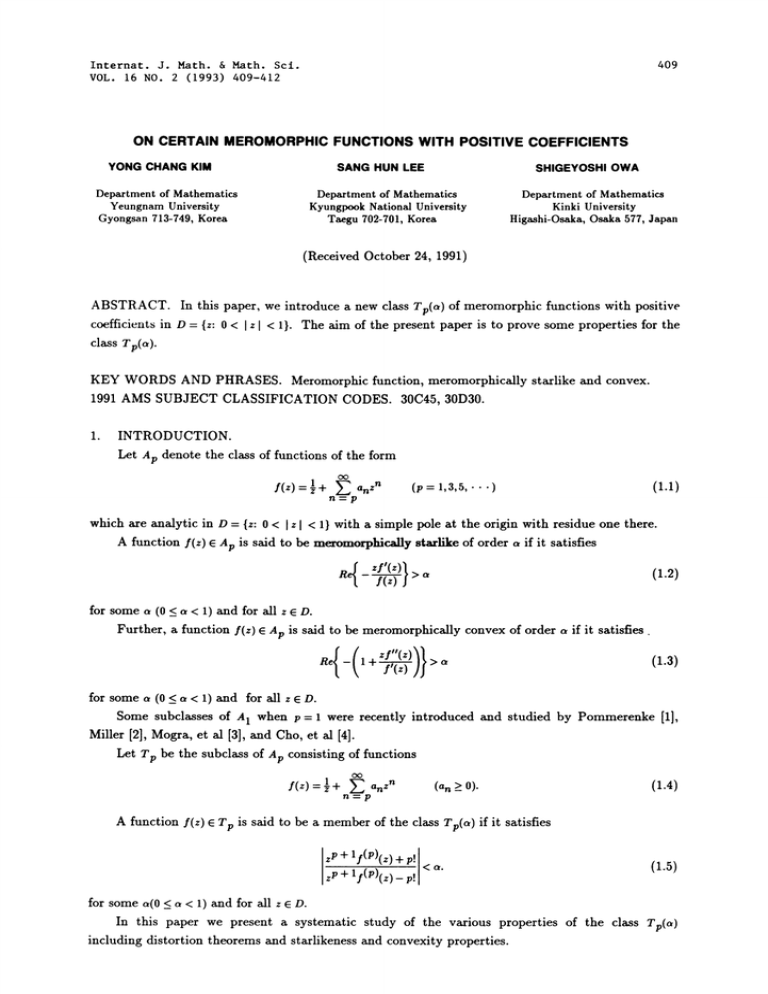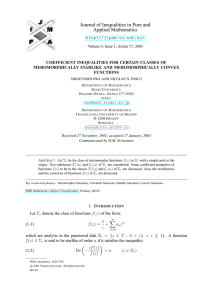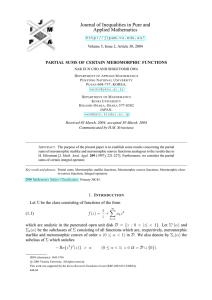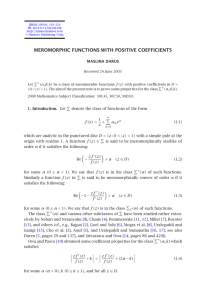Document 10438842
advertisement

Internat. J. Math. & Math. Sci.
VOL. 16 NO. 2 (1993) 409-412
409
ON CERTAIN MEROMORPHIC FUNCTIONS WITH POSITIVE COEFFICIENTS
YONG CHANG KIM
SANG HUN LEE
Department of Mathematics
Yeungnam University
Gyongsan 713-749, Korea
SHIGEYOSHI OWA
Department of Mathematics
Kyungpook National University
Taegu 702-701, Korea
Department of Mathematics
Kinki University
Higashi-Osaka, Osaka 577, Japan
(Received October 24, 1991)
ABSTRACT. In this paper,
coefficients in D
class T p(a).
we introduce a new class
Tt,(a) of meromorphic functions with positive
{z: 0 < [z[ < 1}. The aim of the present paper is to prove some properties for the
KEY WORDS AND PHRASES. Meromorphic function, meromorphically starlike and
1991 AMS SUBJECT CLASSIFICATION CODES. 30C45, 30D30.
1.
convex.
INTRODUCTION.
Let At, denote the class of functions of the form
.f(z)=
l+ n=t,
E anzn
(1.1)
(t,=I,3,5,--.)
which are analytic in D {z: 0 < z[ < 1} with a simple pole at the origin with residue one there.
A function f(z) At, is said to be meromorphically starlike of order a if it satisfies
R
(1.2)
c
f(z) J >
for some
a (0 _< a < 1) and for all z D.
Further, a function f(z). At, is said to be meromorphically convex of order
lie
for some
1+
if z
,]J
>a
a
if it satisfies
(1.3)
(0 _< a < 1) and for all z D.
Some subclasses of A when l0
were recently introduced and studied by Pommerenke [1],
Miller [2], Mogra, et al [3], and Cho, et al [].
Let Tp be the subclass of At, consisting of functions
a
f(z)
,
1 + n--panzn
(a n > 0).
(1.4)
A function f(z) Tt, is said to be a member of the class Tt,(a) if it satisfies
zp +
zp +
lf(P)(z
lf(P)(z
+ p! <
p!
..
(1.5)
for some a(0 _< a < 1) and for all z e D.
In this paper we present a systematic study of the various properties of the class Tp(a)
including distortion theorems and starlikeness and convexity properties.
Y.C. KIM, S.H. LEE AND S. OWA
410
DISTORTION THEOREMS.
We begin with the statement and the proof of the following coefficient inequality.
THEOREM 2.1. A function l{z) Tp is in the class Tp(a) if and only if
(2.1)
an<- l+a’
where
..(n-p+l)
PROOF. Assuming that (2.1) holds for all admissible a,
I + I()() + !1
z-l
I + lI()()- !1
n!
(.- p) (I 4- )art
_<
Therefore, letting
-
we have
(2.2)
z
-, we obtain
oo
E
(2.3)
-p). (l+a) an-2a’p!<-O
n=p
which shows that f(z) e Tp(a).
Conversely, if f(z) Tp(a), then
Since Re(z)<_
anzn + <a
r p (n-n!p)! anzn +1
EO0
n
lf(p)(z) + p![
z p+II(p)(z) p!
zp +
2.p!
p
n!
(n p)!
(zD).
(2.4)
n
zl for all z, (2.4) gives
n
R
2.p!
yo
n
.nn
anzn + 1
(n_ P)!
n!
p (n- p)!
<a
(z D).
(2.5)
Choose values of z on the real axis so that z p+ l/(P)(z) is real. Upon cleating the denominator in
(2.5) and letting z--*l-, we have
n=
p(. _n!p)!(1 +a)an
<_ 2a. p!
(2.6)
which is equivalent to (2.1). Thus we complete the proof of Theorem 2.1.
in Theorem 1, we have
Taking p
COROLLARY 2.1. I(z) Tl(a) if and only if
2a
(2.7)
n--1
THEOREM 2.2. If f(z) Tp(a), then
and
p!2a
f(J)(z)l > j! (p-)!(l+O
-izli+l
p!2a
Izlp-j
f(J)(z) _< j! + (p- j)!(1
+,)
izlJ+
(2.s)
(2.9)
CERTAIN MEROMORPHIC FUNCTIONS WITH POSITIVE COEFFICIENTS
411
j)
for z D, where 0 < j < p and 0 < o < p!2 J!(Pj!(pEqualities in (2.8) and (2.9) are attained for the function
z.
(z)
1 +__
(2.10)
PROOF. It follows from Theorem 2.1 that
an
Therefore,
+ a)a n <_ 2a.
<_
n--
B----p
we have
J!
-[z[ j+l
f(J)(z)l
>
f(J)(z)]
<_
p!2a
(p-j)!(1
j!
n!
[z p- j
(2.12)
p!2a
]zIp-j"
+ (p 1)!(1
/)
(2.13)
n=p(n-J) wanlz[n-j>- izlj+
and
J!
j!
n!
]zlj/
Theorem 2.2, we have
COROLLARY 2.2 If f(z) Tp(ot), then
Taking
j
0 in
p _< If(z)l
2a
]ST-Izl
<-]-/ la
P
(2.14)
for z e D. Equalities in (2.14) are attained for the function f(z) given by (2.10).
in Theorem 2, we have
Making j
COROLLARY 2.3. If f(z) e Tp(a), then
2ap
2ap
(2.15)
--_.
for z e D, where 0 < a <
Equalities in (2.15) are attained for the function (z) given by
in Theorem 2.2, we have
Letting p
COROLLARY 2.4. If f(z) Tl(a), then
2
If(z)l
Izl- 1-- Izl
(2.10).
(2.16)
<--l-/
and
2a
i;12--for z e D. Equalities in
(2.16)
and
_< If’()l _<
2a
+ ,---z
.
(2.18)
STARLIKE AND CONVEXITY.
THEOREM 3.1. If f(z) e Tp(a), then f(z) is meromorphically starlike of order
< r 1, where
-
)1 +a)(1-6) /
l(
rx=infp(n>_ "r7"(:6) J
The result is sharp for the function
PROOF. It is sufficient to show that
zff(z)
f--- +
for [z[ <rl. We note that
(2.17)
(2.17) are attained for the function
s()
3.
2a
i-/l/
6 (0
< 6 < 1) in
n+l
n
<1-6
(n>_p).
(3.1)
(3.2)
(3.3)
Y.C. KIM, S.H. LEE AND S. OWA
412
n= p (n + 1)anzn < E n_- p (n+ 1)anlzl n+
, nC=
+
an zn
p
1-
(3.4)
En= p anlzl n+
Therefore, if
n+2-6
n=p
then
1-
anlzln+l <l’
(3.5)
(3.3) holds true. Further, using Theorem 2.1, it follows from (3.5) that (3.3) holds
Izln+l < (X2a
(n>p),
(3.6)
/(X +a)(1-6)/n
(n>_p).
(3.7)
n+2-6
1or
true if
l+a)
This completes the proof of Theorem 3.1
THEOREM 3.2. If f(z)_ Tp(a), then f(z) is meromorphically convex of order 6 (0 < 6 < 1) in
zl < r 2, where
+a)(1-6) n+
i"l.>_
2
The result is sharp for the function l(z) given by
PROOF. Note that we have to prove that
(3.s)
J
2-a-ff( =-i
(3.2).
zfu(z) 2 _< 1-6
if(z) +
for zl < r 2. Since
, n=
_..
p
n(n + 1)an zn-
+ y]
(3.9)
End= p n(n+ 1)anlZl n+
n= P nanzn
<
+ 2 6)
1-6
zln+
Yn= p nanlzl n+
1-
(3.10)
we see that if
Or
n(n+2-6)
1-6
[z in + _<
an
(X2al+a)
< 1,
(n > p),
(3.11)
(3.12)
then (3.9) holds true. Therefore, f(z) is meromorphically convex of order 6 in zl < r2.
ACKNOWLEDGEMENT. The first and second authors were partially supported by a research
grant from TGRC-KOSEF of Korea. We are thankful to Professor H.M. Srivastava of University of
Victoria for his valuable comments on the subject.
REFERENCES
1.
2.
3.
4.
5.
POMMERENKE, Ch., On meromorphic starlike functions, Pac. J. Math. 13 (1963), 221-235.
MILLER, J.E., Convex meromorphic mapping and related functions, Proc. Amer. Math. Soc.
25 (1970), 220-228.
MOGRA, M.L.; REDDY, T.R. & JUNEJA, O.P., Meromorphic univalent functions with
positive coefficients, Bull. Austral. Math. Soc. 32 (1985), 161-176.
CHO, N.E.; LEE, S.H. & OWA, S., A class of meromorphic univalent functions with positive
coefficients, Kobe J. Math. 4 (1987), 43-50.
LEE, S.H. & OWA, S., Certain classes of univalent functions with the fixed second coefficient,
Kyungpook Math. J. 31 (1991), 101-112.





![Mathematics 414 2003–04 Exercises 5 [Due Monday February 16th, 2004.]](http://s2.studylib.net/store/data/010415766_1-b65af2bb66ab8e422354912dcedcb6a6-300x300.png)





